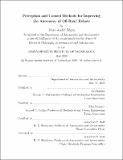Perception and Control Methods for Improving the Autonomy of Off-Road Robots
Author(s)
Bégin, Marc-André
DownloadThesis PDF (48.07Mb)
Advisor
Hunter, Ian
How, Jonathan P.
Leonard, John
Terms of use
Metadata
Show full item recordAbstract
Despite their growing use in outdoor agriculture, mobile robots remain challenging to operate under off-road conditions. The agricultural robot designed as part of the present work, nicknamed RoverII, offers a good case study since it was developed for field-surveying tasks on dairy farms and needs to operate autonomously on uneven terrain and under light conditions that are challenging for visual perception. This thesis aims at improving the autonomy of off-road robots by addressing two key problems encountered with RoverII. First, it requires a suspension to quickly traverse uneven terrain. As a result, the control of its robotic manipulator is complicated by the dynamic coupling with the suspension. Based on Lyapunov’s stability theory, this thesis contributes RaPID, a tuning procedure for the PID control of suspended manipulators that guarantees the stability of the system. The algorithm applies to any serial manipulator mounted on a flexible base and does not rely on linearization. To facilitate its adoption among control designers, an open-source implementation of RaPID is shared with the robotics community. Second, robot Visual Odometry (VO) is particularly sensitive to road vibrations and fast maneuvers. These effects are even more prominent in low-light settings where underexposure, motion blur, or image noise can degrade VO performance depending on the exposure parameters selected by the camera. This thesis contributes VO-AutoExpose, an auto-exposure algorithm that, unlike existing ones, predicts exposure parameters maximizing VO performance by fully leveraging the camera’s photometric response function and by explicitly balancing motion blur and image noise effects. Together, these features allow VO-AutoExpose to outperform state-of-the-art auto-exposure algorithms in challenging light conditions. Finally, while a majority of works in the VO literature rely on standard datasets, the experimental validation used in the present work directly compares the performance of different auto-exposure algorithms by accurately repeating the same camera trajectory multiple times on a custom positioning table.
Date issued
2022-05Department
Massachusetts Institute of Technology. Department of Aeronautics and AstronauticsPublisher
Massachusetts Institute of Technology